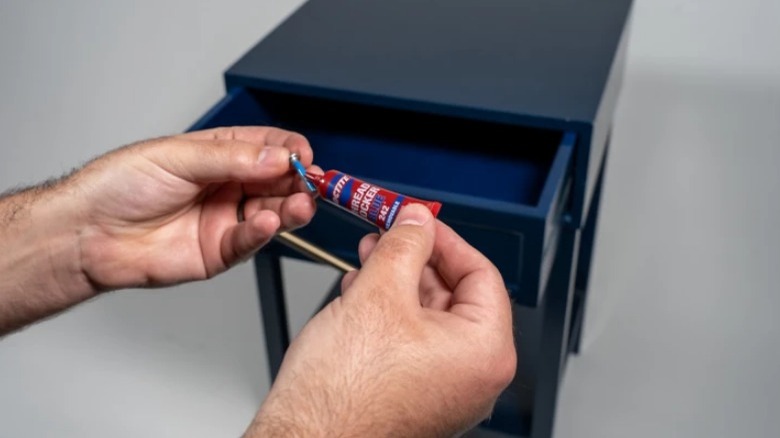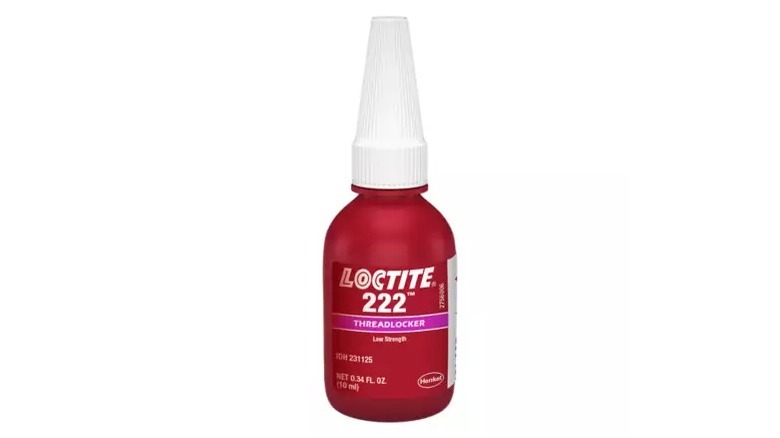6 Handy Uses For Loctite Threadlocker (And Which Colors You'll Need)
If you've spent much time working in any sort of DIY space you've probably come across Loctite Threadlocker at one point or another. Loctite makes all kinds of adhesives, including plastic superglues and a clear adhesive for assembling touchpanels, but the brand is most well-known for adhesives used to secure fasteners. Threadlocker is designed to hold nuts, bolts, screws, and other threaded pieces in place, keeping them from loosening when they vibrate and providing leak protection.
You might think that all glue does roughly the same thing — sticking one object to another — but different kinds of adhesive have properties, making them ideal for different uses. Loctite makes four types of color-coded threading adhesive: Blue, Red, Green, and Purple. Each offers different adhesion strength and has qualities that make them ideal for different utilities. Blue is the most popular, as it's designed to hold fasteners firmly in place and fill the gaps between the threading while also being removable, so you can still disassemble the fasteners later if need be. Red is the strongest, Purple is the weakest, and Green is designed to work with pre-assembled components.
Knowing this, you might be interested in learning what kinds of jobs you can use Loctite Threadlocker for, and which color you'll need in order to do the job right.
Engines – Blue
Gas engines are an obvious candidate when you start talking about fasteners coming loose due to vibration. Few things vibrate more fiercely than a steel box designed to contain thousands of tiny explosions, after all. That said, you probably don't want to permanently seal your engine casing shut. Doing so would prevent you or your mechanic from opening it for needed maintenance. This is why Threadlocker Blue is a good solution.
Car and motorcycle engines, as well as most of the other auto parts that you'll find under the hood, need to remain removable. Even so, old, corroded, and weathered fasteners (and their respective threading) may lose their ability to hold up to heavy vibration over time. Its liquid sealing capabilities also have the added benefit of helping to prevent fluid leaks from things like oil and coolant should you choose to use it on any related components. On top of all that, it has an operational temperature that reaches up to 300 degrees Fahrenheit, making it more than capable of standing up to high engine heat.
Threadlocker might not be the best long-term solution in many cases, however. You may be better off treating the source of the problem rather than putting a bandaid on a symptom. But it's often an excellent temporary solution if you're tight on funds and just need something to hold your fasteners together for a little while.
Power tools – Blue
Do you know what else is subject to an abundance of vibration and held together with a bunch of metal fasteners? Power tools. It doesn't matter if you're talking about a drill or a sander, nearly every power tool in your garage is held together by screws and bolts with the capacity to come apart under the stress created by the tool's own motor. This kind of problem can often become more pronounced as a tool gets older. It's annoying at the best of times, but it can also be dangerous if left unchecked for too long.
Blue Threadlocker can be a useful adhesive for securing the fasteners in your tools. You can use it on the small screws that hold your tool's casing in place like the ones you might find on a circular saw or an impact wrench, and also use it on the larger bolts that you more often find in the assembly of larger power tools, such as a table saw. It's particularly good for tools that tend to suffer a lot of physical wear and tear, like lawnmowers — a common use for Threadlocker is to secure loose fasteners holding a wobbly push bar.
Furniture – Blue
If you've ever had to assemble something from Ikea or any other big-box store, you probably never want to have to reassemble it again. You might need to leave a few connectors detachable on a big item like a bed frame or a sectional couch if you ever want to be able to get them out of your house, but most of the nuts and bolts holding your furniture together are meant to be fixed in place. No one likes a wobbly table or an unsteady chair. Adding a bit of Threadlocker Blue to these threaded connections will help keep them fixed and stable, and in turn help prolong the life of your furniture. I've personally used it in doorknobs that were coming loose and several lamps that had a simple bolt connecting the stand to the base. The Threadlocker kept the lamps straight, sturdy, and perfectly upright when they had previously been leaning due to the bolt coming loose after being moved for cleaning.
This can apply to homemade furniture as well. Threadlocker won't be much help for biscuit or peg-based wood joinery, but it will ensure that any lag bolts you might use remain snug, and help to maintain the structural integrity of the piece.
Structural bolts – Red
Threadlocker Blue gets used a lot more often than the Red version because most fasteners will probably need to be disassembled at some point. Red offers a stronger, but much more permanent solution. It can technically be removed, but doing so requires the use of a blowtorch, a wrench, and more than a little elbow grease. For jobs where you know that once a bolt is in place, you're never going to move it again, this is the adhesive to use.
Structural bolts are a good example of this. These could be the thick fasteners that connect the structural beams at the foundation of your house, or those attached to the pillars beneath a deck. Granted, these fasteners aren't usually subject to an abundance of vibration, but they are the kinds of fasteners that you never want to come apart, so you probably want them to be as secure as possible.
Loctite recommends using Threadlocker Red for these applications as it is significantly stronger than any of the company's other products. Breaking a bolt held in place with this adhesive requires a breakaway torque of between 40 and 350 lb-ft depending on the width and material of the fastener. It's also better for these applications because it works well on larger fasteners. Loctite recommends using the Red formula on nuts and bolts that are up to an inch thick, while it only recommends using the Blue on fasteners from 6-19 millimeters.
Pre-assembled fasteners – Green
Sometimes fasteners come preassembled, but you may still wish to add Threadlocker to them so they stay secure. You can always take them apart and add the Blue formula, but that's a lot of extra work. It's much easier to just add a thinner adhesive to the top of the threading. That's where the Green Loctite comes into play. While the other colors are thicker and designed to cling to the gaps between threading prior to being assembled, the Green formula has a much lower viscosity. This allows it to flow through the tight crevices between pre-assembled fasteners and fill the spaces in between.
This is often used simply for the convenience of not having to disassemble and reassemble the fasteners that you want adhered to, but Loctite suggests it's particularly good for electrical connectors which may involve delicate wires that you don't want to risk damaging in the process. It's worth noting, however, that Threadlocker Green is classified as a medium-high strength adhesive. So while it isn't quite as strong as the Red formula, it will still require heat for removal.
Delicate machines and electronics – Purple
More than just big steel engines and heavy furniture can take advantage of Threadlocker. Smaller machines and electronic devices like clocks, computers, and gaming systems are held together by fasteners that can be stripped just as easily — if not more so. You don't want to leave the back panel of a laptop hanging off just because the screw that's supposed to be holding it together is loose.
Threadlocker Blue might be a bit strong for these kinds of delicate applications though. You don't want to accidentally break off one of those tiny screws that you locked in place the next time that you need to open it up. Threadlocker Purple is the best solution for these devices. It has a much weaker bonding strength that's just strong enough to hold small fasteners (under ¼-inch in diameter) in place while being easy enough to break that you can still remove it with basic hand tools. This makes it particularly good for electronic devices that are handled frequently or subject to a lot of movement. It's nice to have a few drops of Purple around if you notice screws starting to slip from your 3D printer or your Xbox controller.






